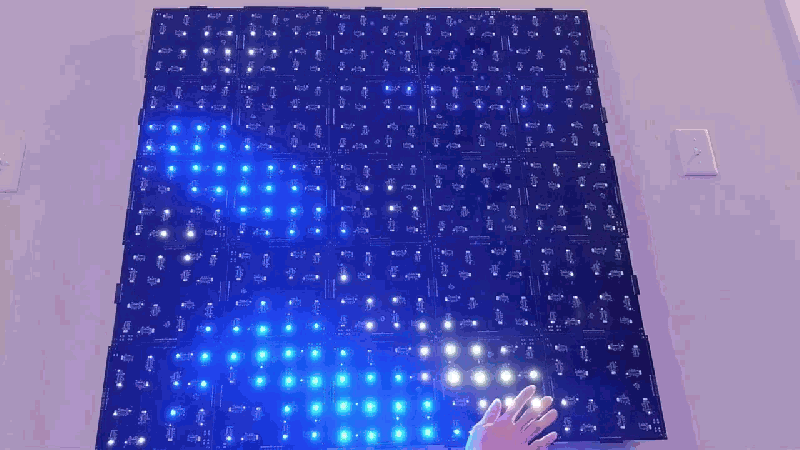A while back, [Chris Lu] was studying how analog circuits, specifically op-amps can be used to perform mathematical operations and wondered if they could be persuaded to solve differential equations, such as the wave equation. After sitting on the idea for a few years, it was time to make it a reality, and the result is an entry into the Op-Amp Challenge.
 Unlike many similar interactive LED matrix displays that are digital in nature (because it’s a lot easier), this design is pure analog, using many, many op-amps. A custom PCB houses a 4×4 array of compute units, each with a blue and white LED indicating the sign and magnitude of the local signal.
Unlike many similar interactive LED matrix displays that are digital in nature (because it’s a lot easier), this design is pure analog, using many, many op-amps. A custom PCB houses a 4×4 array of compute units, each with a blue and white LED indicating the sign and magnitude of the local signal.
The local input signal is provided by an IR photodiode, AC coupled to only respond to change, with every other circuit sharing a sensor to keep it simple. Each circuit is connected to its immediate neighbors on the PCB, and off the PCB via board-to-board connectors. This simple scheme makes this easily scalable if desired in the future.
[Chris] does a great job of breaking down the math involved, which makes this project a neat illustration of how op-amp circuits can implement complex mathematical problems in an easy-to-understand process. Even more op-amps are pressed into service for generating the split-rail voltage reference and for amplifying the weak photodiode signals, but the computation circuit is the star of the show.
We like analog computing a fair bit around these parts. Here’s a little something we were previously drooling over.

















This is so pretty and elegant. I wonder if it can be wired as a neural network?
No reason why you couldn’t make a neural network using op amps, a summing amplifier may be all that is needed for a basic system (more complex systems may need many op amps per neuron), but each neuron needs weights and biases and whilst they could maybe be set with resistors it would be difficult to change them afterwards, maybe you could use DACs or adjustable linear regulators or potentiometers but it still wouldn’t be that easy to set.
It is a common problem with analogue computation, they are made for a specific purpose and are very hard to adapt to other purposes without making a whole new circuit. I have heard of things called Field Programmable Analogue Arrays (FPAA) which is similar to an FPGA but for analogue signals, as far as I know though there hasn’t become mainstream yet.
I wonder if this could be used to stimulate flow in sewage pipes? Like what happens when you flush because in places like Norway or Ireland water spins one way, in places like Australia or Peru water spins the other way, all due to gravity-relativistic effects.
While the Coriolis effect is real, it’s best observed at large scale and your crapper isn’t really large scale. The direction of the draining water has more influence from the shape and asymmetry of the drain/bowl as well as an residual currents (or matter…).
Although I think Australia should pass a law mandating that all toilets, sinks and bathtubs should should be designed to drain in a counter-clockwise motion.
What about Africa?
Oi mate, you’re going to get a booting for that!
If you’re at the equator, the water just goes straight down. It’s bizarre to watch
OK, now that’s a cool original hack !
Didn’t EMSL do something like this a long time ago?
Yes, they showed it at Maker Faire #1.
It probably was at some point, when analog computers were a thing.
In reply to the question, “I wonder if this could be used to stimulate flow in sewage pipes?”
This is really great! Beautiful, in many regards: form, function, design, the level of understanding taken to create this, the shear patience and persistance in making 100 of them…. So great.
The only thing that could possibly improve the wow-factor slightly is if somehow the LEDs themselves could be used as the sensors.
When I was in college (a LONG time ago), there was still enough skepticism about the future of digital computers that we were forced to have a parallel lab using analog modules to solve equations. We connected them together in building block fashion.
Today they force student to dick around with blocks in Simulink, equally pointless when every control problem can be solved with a $5 microcontroller.
Yes, just like teaching students arithmetic when all maths problems can be solved with a calculator.
Disappointed… I’m sure you could’ve come up with a dozen better analogies…
How about learning to write, when we can just type? Or maybe going for a walk, when we could just tie the dog to a post? Or learning to ride a bike, when we could just keep using training wheels?
Nevermind the whole shebang about… yahknow… whether the person programming the microcontroller, website, database, etc. really even understands the problem.
It’s all about the ride, and how many you can get to join you. Whatever it takes to get the next generation excited is likely worth it. Keep on rockin’ in the free world. Speaking of which, better yet, It’d be neat to see a spin off of this project come out of a adolescent in Ukraine. S/he could (say) cite Maxwell complimenting Faraday whilst banging out a riff from Hackaday’s favorite anti hate band. #GuitarScratchGuardContest
You definitely can implement an analog neural network with op-amps! I’m working on one right now that uses fixed resistors, so it can’t easily be modified after assembly, but is a lot more tractable than using hundreds of pots or other variable elements.
They sure did. My project was partially inspired by their work:
https://www.evilmadscientist.com/2007/interactive-led-coffee-tables/